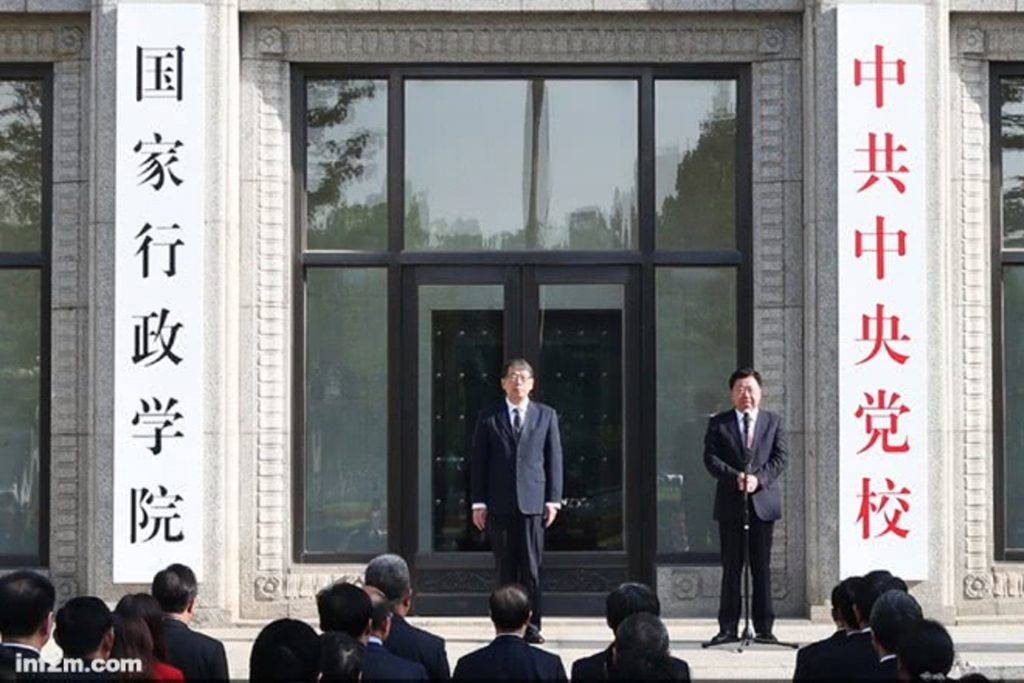THE CMP DICTIONARY
One Institution with Two Names
One Institution with Two Names
For those unfamiliar with the inner workings of China’s political system, it may seem odd that a single office, performing one set of duties, would be given two distinct names. But this long-standing practice, described in the phrase “one institution with two names” (一个机构两块牌子), is rooted in the parallel structure comprising the Chinese Communist Party (CCP) and the Chinese state — a Leninist model adopted from the Soviet Union in the 1920s and refined over many decades. While the Party and the state are nominally separate in China, they are functionally twinned, and sometimes distinguishable by name only. The bottom line: it is the CCP that ultimately controls the state.
Despite the political supremacy of the Party, however, it is often seen as necessary to emphasize administrative roles over political ones. The changing of a sign, often through a process known as “adding a name” — literally, “hanging an additional signboard” (加掛牌子) — can achieve this goal, emphasizing the government identity of an body in one capacity and in the process disguising its roots in the Party structure. In some cases, signs may be added to adjust to external perceptions. In other cases, it can be used to fuse the functions of one organization into another, perhaps asserting CCP dominance over an office or related functions.

One of the best examples of the former case is the recasting of the overseas work of China’s Central Propaganda Department in the wake of the Tiananmen Square massacre in 1989, as the leadership sought to manage and improve relations with the outside world. In 1991, the CCP Central Committee decided to rename the External Propaganda Leading Group (中央对外宣传小组), the foreign communication body under the Central Propaganda Department, as the State Council Information Office (国务院新闻办公室), or SCIO. While some may have had the illusion since that time that the SCIO sits under the government, and serves as its external communication body, it is in fact the same office as the Party’s Central Propaganda Department — “one institution with two names.”
Cases like this are sometimes referred to as “externally reserving a name” (对外保留牌子), which is essentially about creating the false impression that there are two separate institutions. The hope is that the SCIO will seem to outsiders to be no different from the Information Commissioner’s Office in the UK, or the Government Information Office in Taiwan, both of which conduct public relations and facilitate information release but do not — as in the case of China’s powerful propaganda department — have the power to control and discipline media.
While the “one institution with two names” practice may at first seem conspiratorial, the process is not hidden. In fact, the tactic is openly discussed in state media and acknowledged in official documents. The Central Institutional Organization Commission (中央機構編制委員會) defines it as follows:
“The so-called ‘one institution’ (一个机构) means one legal representative, one set of resources, one leading group, and one personnel team. The so-called ‘two signboards’ (两个牌子) means that the organization has two names, one of which is used externally according to the needs of its work.”
There are two ways one institution acquires two names. The first is by “adding a name,” a process by which two institutions or offices are fused together, with the original unit taking on the duties of the added one using only its existing resources. Although it is registered under just one name and has one set of personnel, the amalgamation carries out multiple roles and can be known by more than one name.
For an example of this in action, consider this 2023 State Council circular outlining wide-ranging reforms to change the Party and state structure. In section 5, it lays out the following:
“The Hong Kong and Macao Affairs Office of the State Council has been added (加掛牌子) to the Hong Kong and Macao Work Office of the Central Committee of the Communist Party of China, with the Hong Kong and Macao Work Office of the Central Committee of the Communist Party of China assuming the relevant responsibilities.”
In essence, this means that the Hong Kong and Macao Affairs Office of the State Council, which since 1978 has coordinated ties between mainland China and Hong Kong, will now be run by a work office of the CCP Central Committee — a new sign to add to the front door. It is also an example of how reforms aimed to give more autonomy to state organs and local bureaucracies in the post-Mao reform era have been reversed under Xi Jinping, who has enacted a takeover of state functions and offices by the CCP to reflect his belief that the Party should lead in all spheres. In the case of Hong Kong, the reshuffle is a reflection of how central authorities tightened their grip over the city after pro-democracy protests drew millions to the streets in 2019.

Bertie Lyhne-Gold
The CMP Dictionary
C
D
F
G
M
N
P
S
- Scaling the Wall
- Science
- Second-Generation Reds
- Security
- Seeking Progress in Stability
- Seeking Truth From Facts
- Self-Revolution
- Seven Bottom Lines
- Six Adheres
- Smart Governance
- Sneaky Visit
- So-Called
- Socialite
- Soft Resistance
- Soul and Root
- Soundless Saturation / Quietly Nourishing
- Sovereignty
- Speaking Politics
- Streamlining Services
- Strong Cyber Power

